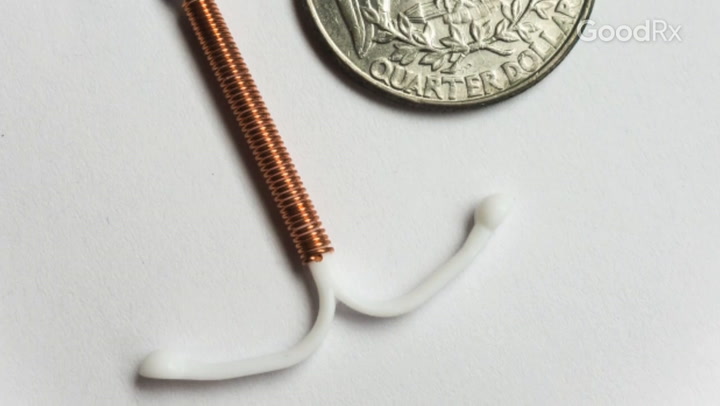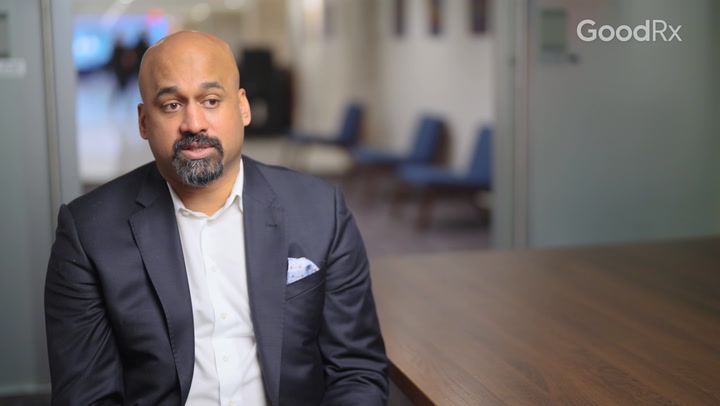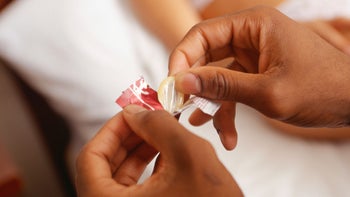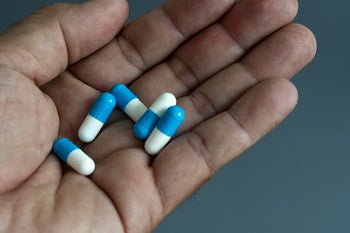
The Woman’s Guide to A Healthy Sex Life
The basics
According to the World Health Organization, a healthy sex life is more than just an absence of disease. Sexual health means enjoying physical, emotional, mental, and social well-being when it comes to sex. It also depends on a positive approach to sex, as well as the safety and security to pursue whatever activities are pleasurable for you — without coercion, discrimination, or violence.
Table of contents

Nearly 75% of women will have pain during sex at some point during their lives.
That said, sex can feel pretty complicated sometimes, partially because your sex life is affected by so many different things: your physical body, your feelings and emotions, and even your culture and environment. In this guide, we’ll help you to better understand what goes into a healthy sex life, and how to take action if there are things you’d like to change.
But first, a few definitions:
Sex: Sex includes all of the different behaviors and activities that humans use to express their sexuality. And the truth is, there’s no one single definition for “sex.” For some people, sex only means vaginal (penis-in-vagina) intercourse. But for many other people, sex also means other activities, including touching or rubbing genitals, masturbation (touching yourself), and oral or anal penetration.
Libido: Libido is your “sex drive.” It’s your desire to have sex, think about sex, or engage in other sexual activities. Libido can vary from person to person and throughout your lifetime.
Arousal: Sexual arousal is your body’s physical and emotional response to sexual stimulation. In other words, it’s when you feel “turned on.” When you are aroused, you may find yourself becoming more interested in having sex. Your genitals may become more sensitive or wet, and your clitoris, nipples, or penis can become erect.
Orgasm: Orgasm is the physical and emotional climax of sexual excitement. It often follows arousal, especially during sex or masturbation. Orgasm is usually accompanied by a pleasurable feeling throughout your genitals and body. Your body also releases endorphins (feel-good hormones) that can make you feel relaxed and happy.
In a 2014 survey of over 6,000 people, lesbian women had more orgasms than heterosexual or bisexual women.
And just one additional note: Although we’ve tried to make this guide as inclusive as possible for all women, we admit much of the language here is centered on cisgender women with vaginas. All the same, we know that people’s bodies (and genitals) come in all shapes and sizes, and we want to emphasize that all women are welcome here.
Quiz: Am I asexual?
Is my sex life healthy?
It’s natural to wonder whether your sex life is healthy. You may have questions about whether you’re having “enough” sex, or how your sex life compares to other people.
But the truth is: There’s no real “normal” when it comes to sex. There’s a wide range when it comes to how frequently people think about sex and have sex, how often they have an orgasm, and how much they enjoy sex. It’s also common to go through changes in sex and libido throughout your life — like with menopause, pregnancy, or major life events like marriage or childbirth.
In women, problems with libido peak between the ages of 40 to 60.
When it comes to your sex life, what really matters is how you feel. The bottom line is: If you are satisfied and happy with your sex life, then it’s healthy. But if your sex life causes distress, sad or worried feelings, or harmful consequences — either for yourself, or for others — then it’s possible that you could have a sexual health problem that needs to be addressed.
What types of sexual health challenges can women face?
If you’ve ever felt unhappy about your sex drive, your ability to get aroused, or your ability to enjoy sex, you’re not alone. In fact, a 2016 meta-analysis found about 40% of premenopausal women worldwide had experienced challenges with their sex life.
Read more like this
Explore these related articles, suggested for readers like you.
Though there’s a lot of overlap, sexual problems tend to fall into one of these five categories:
Libido (desire) problems: Having a low libido is one of the most common sexual problems, affecting over 28% of women worldwide. People with a low libido are often less interested in sex than they would prefer and have very few sexual thoughts and fantasies. Having a low libido can also decrease your interest in masturbation, or in initiating sex with a partner.
Arousal problems: People with arousal problems have a hard time getting physically “turned on” before or during sex. You may have a harder time getting lubricated (wet), and might feel like your erogenous zones are less sensitive. You might also feel distracted during sex, or find sex less exciting or pleasurable.
Trouble with orgasm: Orgasm problems are when you are not satisfied with the frequency or quality of your orgasms. You might have a hard time reaching orgasm, take an especially long (or short) time to orgasm, or find that your orgasms are less pleasurable than usual — even when you are sexually aroused.
Pain or discomfort during sexual activity: Some women experience pain or discomfort with sex, genital contact, or other sexual touching. Muscle spasms or mobility problems can also make sexual penetration and positioning challenging.
Sexual problems caused by medications or illnesses: Many medications or chronic illnesses can cause sexual problems in all of the above categories (libido, arousal, orgasm, and pain).
What causes women’s sexual health problems?
There are many things that can affect your sex life: your mental and physical health, your emotions, and even your lifestyle. Your sex life is also influenced by past experiences, cultural beliefs and messages, and your current and past relationships. All of these things can influence how you think about and experience sex.
Here are just some of the many different factors that can affect your sex life.
Physical conditions
Heart and blood vessel disease
Neurologic and psychological disorders
Hormonal changes (like pregnancy or menopause)
Chronic liver or kidney disease
Alcohol or substance abuse
Sexually transmitted infections
Gynecological conditions
Psychological factors
Stress
Fear
Concern about sexual performance
Relationship problems
Depression
Anxiety
Guilt
Concerns about body image
Past or current sexual trauma or abuse
Inexperience
Medications
Hormones
Heart medications
High blood pressure medications
Psychiatric medications
Opioids
Social factors
Sexual identity conflicts
Sexual performance expectations
Religious beliefs or taboos
Cultural beliefs or taboos
Impact of sexual problems on daily life
Sexual challenges can impact not only your personal sexual satisfaction but also your relationships, your self-esteem, and your mental health. You may even find that problems with your sex life lead to feelings of shame or embarrassment.
In a 2015 FDA research discussion with women, here’s what participants had to say about how problems with libido and arousal had affected their lives:
“[My partner] feels stupid at times when he keeps getting shut down. I know he feels rejected.”
“I lost a major relationship to this issue, and I never want to go back there.”
“[My condition] affects things like my self-confidence and how I approach the world.”
“I became so frustrated that any attempt to have [sex] would end up in me crying.”
“I find myself avoiding any situations where a sexual experience may occur . . . going to bed after my husband fell asleep or jumping out of bed in the morning before he got up . . . .”
Getting a diagnosis
Sexual health conditions (sexual disorders)
If you feel sad, discouraged, or anxious about your sex life, it’s possible that you could have a sexual health condition (sexual disorder). Sexual disorders are sometimes grouped together under an umbrella diagnosis called female sexual dysfunction (FSD).
In one study of over 30,000 women, 21% had significant problems with orgasm.
In general, FSD includes any persistent, recurrent sexual problem that puts a strain on your personal life or relationships. In most cases, the symptoms need to bother you for at least 6 months — and make you feel unhappy in some way — to be considered a sexual disorder.
Here are some examples of sexual disorders.
Female sexual interest/arousal disorder (FSIAD)
Women with this disorder have a very low libido and/or problems getting sexually aroused. FSIAD is sometimes divided up into two separate conditions: hypoactive sexual desire disorder, or HSDD (low libido), and female arousal disorder (low sexual arousal). In both cases, the symptoms are severe enough to cause personal or relationship distress. Some people have this condition for their whole lives. Other times, it can be caused by a certain situation, like stress or pregnancy.
Hypersexual disorder (or sexual addiction)
People with hypersexual disorder (or sexual addiction) are preoccupied with sex, and can find sexual behaviors difficult to control — even when the behaviors have negative consequences.
Persistent genital arousal disorder (PGAD)
This is a rare disorder where women have sudden, frequent genital arousal. It is also called persistent sexual arousal syndrome. In PGAD, the genital arousal is not associated with sexual desire or activity, though it can sometimes lead to orgasm. People with PGAD usually find the arousal distressing, rather than pleasurable.
Female orgasmic disorder (FOD)
Women with female orgasmic disorder (FOD), or anorgasmia, are almost never able to have an orgasm, even when sexually aroused. In this condition, the problems with orgasm are ongoing and cause you to feel sad, worried, or anxious.
Female premature orgasm (FPO)
Women with female premature orgasm (FPO) regularly have orgasms too quickly when aroused, to the point where it causes personal or relationship problems.
Genito-pelvic pain/penetration disorder (GPPD)
In this condition, women have either ongoing pain and/or difficulty with vaginal penetration. This disorder is sometimes divided up into two separate conditions: dyspareunia (pain during sex) and vaginismus (muscle spasms that interfere with sex).
When to see a doctor
Many women go through ups and downs with their sex life over time. But if you are experiencing a problem that’s been hanging around for a while, or if it makes you feel sad, worried, or anxious, it might be worth talking to your healthcare provider. Your healthcare provider can help you understand what might be contributing to your symptoms. They can also check to see whether any medications or underlying medical conditions could be playing a role in your sexual health.
If you already have a primary care provider, or an OB-GYN, they can be a great place to start. It’s OK to make an appointment just to talk about sex, or to bring up your concerns at your next well-woman exam (usually every 2 to 5 years). Even if it feels like everything’s going well with your sex life, talking with your provider about sex can help you create an open relationship where you feel safe bringing up concerns in the future.
And finally: Don’t forget to keep in mind regular testing for sexually transmitted infections (STIs), even if you’re in a long-term partnered relationship. Many STIs can have few or no symptoms, and some can go undetected for years. Your healthcare provider can help you decide which tests are right for you, based on your relationship status, frequency of sexual activity, and number of partners.
Discussing sex with your doctor
If you feel shy or embarrassed about discussing your sex life with your healthcare provider, you’re not alone: Many women feel the same way. But the truth is, most healthcare providers welcome the opportunity to talk with you about sex. From a doctor’s perspective, sex is just another part of your overall health. Talking about sex with your provider can help them to understand what’s important to you and to support you in having (or maintaining) a fulfilling sex life at any age.
In a 2010 survey, almost 25% of partnered women over age 70 had sex more than four times a week.
Here are some tips that can help you prepare for your appointment:
Do some research ahead of time, to help you understand your body and your concerns.
Keep track of your symptoms before the appointment.
Before the appointment, write down the questions and concerns you would like to discuss.
Take a list of your medications and/or supplements with you to the appointment.
Consider bringing a support person (or your partner) with you to the visit.
When talking with your provider, be as specific as possible about what you’re experiencing.
Ask questions, especially if your provider uses words or phrases that you don’t understand.
Don’t end the visit until you feel like you understand — and agree with — the treatment plan.
During the appointment, your provider may ask you some questions about your sex life. Though these questions may seem personal, they help your provider to understand you as a whole person. And rest assured: Your provider is legally required to keep details about your sex life private, just like all of your medical information.
When you meet, your provider may want to know more about:
Your sexual history
Your gender identity and sexual orientation
Your current sexual practices
What birth control (if any) you currently use
Any symptoms you have
If you could be pregnant
If you have recently been exposed to a STI
As part of the interview, some healthcare providers also use a special questionnaire, called the female sexual function index (FSFI). The FSFI is a detailed assessment of sexual function. Women with a higher score may be more likely to have a sexual disorder. Your healthcare provider may also suggest a physical exam (including a pelvic exam) and lab or urine tests. These will help rule out any physical problems that could be affecting your sex life.
And keep in mind: You deserve to feel good about working with your healthcare provider. If you feel unsafe or uncomfortable for any reason, follow your instincts. It’s always OK to get a second opinion, or to look for another provider.
Treatment options
Dealing with a problem in your sex life can be hard — both mentally and physically. But fortunately, there are many options for treatment, including:
Herbal supplements
Prescription medications
Therapies
These treatments can be helpful for everything from mild and moderate symptoms to more severe sexual disorders.
Available treatments can potentially:
Boost your sex drive
Reduce your sex drive
Improve sexual arousal
Make sex more pleasurable
Encourage orgasm
Reduce pain
Address physical challenges and mobility issues
Address physical and psychological trauma
Some treatments and therapies focus on just one or two of these areas. Others are more general. And since different parts of your sex life are connected, making a change in one area can help you in other areas as well. For example, using a lubricant (lube) to help reduce pain during sex could also have the added benefit of boosting your libido, or making sex more pleasurable.
First steps
Before jumping in, ask yourself: What’s most important to me in my sex life? With so many options, it can be helpful to have a sense of what you’d like to change.
Take some time to think about what an “ideal” sex life means to you. Look for sex-positive education resources that can help you understand your body. Also, think about what makes you feel good. If you have a partner, think about including them in the conversation — both for support and for collaboration.
Non-medication treatments
Herbal supplements
There are many natural products on the market that claim to support sexual health. Examples include chasteberry, ginseng, maca, and more. Some products are also specifically marketed for use during and after menopause.
You can read more about specific herbal supplements in these two GoodRx guides:
Ideas to try at home
Get creative: The human brain is hardwired to like novelty (new things) — including when it comes to sex. In fact, there’s evidence that desire and arousal decrease over time if you’re in a monogamous relationship. Consider introducing novelty by experimenting with new sexual positions or activities, reading or watching erotica, or experimenting with sex toys.
Use more lubricant: A water-based or silicone-based lubricant can help with dryness. This can increase arousal and pleasure — and decrease pain — during sex.
Fantasize: Thinking about sex can help with libido and arousal, and it may actually increase testosterone levels, a hormone that is related to sexual function and satisfaction.
Masturbate: Not only is masturbation common (by some estimations, 76% of American women do it), it may help to improve sexual problems. It also increases blood flow to the genital area, which can help to keep vaginal tissue healthy, especially after menopause.
Try using a vibrator: Vibrators are sex toys that can be used on your body to help with sexual arousal or orgasm. Vibrators come in all shapes and sizes, and they’re designed for all genders and body types. Certain vibrators can also be especially helpful for trans women and people with disabilities (link includes explicit images).
Try using a comfort or support device: Positioners (link includes explicit images), spacers, and supports (link includes explicit images) can all help you control your body’s position and movements during sex. These can be especially helpful for people who experience pain during sex or who have a disability (link includes explicit images).
Limit alcohol: One or two drinks can help with arousal, but excessive alcohol use can get in the way of sexual arousal and orgasm.
Stop smoking: Cigarette smoking can decrease blood flow to your genitals and interfere with sexual arousal and orgasm.
Exercise: Physical activity can reduce stress, increase stamina, and enhance well-being, all of which can help to improve your sex life. It may also directly help with sexual arousal and reverse sexual problems induced by antidepressants.
Sexual wellness devices
Sexual wellness devices are medical devices that can help with physical arousal, as well as comfort and enjoyment during sex. Though they are available without prescription, they’re often used under the guidance of a trained health professional like a:
OB-GYN
Pain specialist
Sex therapist
Physical therapist
Here are examples of some sexual wellness devices:
Vaginal dilators (trainers): Vaginal dilators are medical devices that slowly train the vagina to relax with penetration. This can help to treat pain during sex and to reduce sex-related anxiety. Dilators are also used to help with sexual function after cancer treatment and as a standard treatment for trans women who have had (bottom) gender confirmation surgery.
Eros therapy device: The Eros is an FDA-approved medical device used to treat female arousal disorder (FAD). It uses a small vibrating vacuum that increases blood flow to the clitoris, increasing sensation and improving sexual satisfaction.
Kegel exercisers: These are devices used to strengthen your pelvic floor muscles. They can help to improve muscle tone in your genital area, which can help with arousal and orgasm.
Read more about sexual wellness devices — and the scientific evidence behind them — in this GoodRx article about the link between natural products and an improved sex life.
Therapy and education
There’s a huge variety of options when it comes to educating yourself about sex and learning new techniques that can boost your sex life. Some of these options can be done at home on your own. Others require you to work with a trained health professional.
For example, you can educate yourself at home by reading books about sex or taking an online sex education class, like OMGyes or Bodysex (link includes explicit images). Getting educated can guide you to explore new techniques and to understand your body. Ultimately, it can improve libido, arousal, and orgasm.
And if you’d like to work with a professional, there are also many options. Be aware that sexual health professionals are licensed specialists — not sex workers — though some professions do use physical touch. Here are some examples.
Sex therapy
A sex therapist is trained mental health professional with knowledge about sex and relationships. Sex therapists provide counseling designed to help you — and sometimes your partner — understand your thoughts and feelings about sex and to resolve issues in your sex life. Sex therapy does not involve any physical contact between you and the therapist. But they may suggest activities for you to do at home, like sensate focus exercises.
Pelvic floor physical therapy
A pelvic floor therapist is a licensed physical therapist who focuses on your pelvic floor muscles, ligaments, and tissues. All of these parts of your body work together to support your internal organs, control your bowels and bladder, and contribute to sexual arousal and orgasm. The therapist uses a combination of physical techniques to help ease pain and restore normal functioning. Though this is a hands-on therapy, the touching is non-sexual.
Sexological bodywork
Sexological bodywork is similar to pelvic floor physical therapy, but with more of an integrative approach. In addition to hands-on physical techniques, sexological bodyworkers educate their clients about sex, arousal, and orgasm. Be aware that this type of therapy can sometimes involve sexual therapeutic touching.
Prescription medications
For some women, medications are another way to support a healthy sex life. Medications are often used as a second choice, after non-medication options haven’t worked. Below are some examples of medications.
Flibanserin (Addyi)
Addyi is an FDA-approved medication for hypoactive (low) sexual desire (HSDD) in premenopausal women. Addyi is a pill that you take daily. In clinical trials by the manufacturer, women taking Addyi had an increased libido and an increased number of satisfying sexual events per month — though this only happened for about 10% of participants.
Also: Be aware that this medication has only been tested in cisgender, heterosexual, mostly white women. It is also very expensive, and it can also have dangerous side effects when combined with alcohol.
Bremelanotide (Vyleesi)
Vyleesi is another FDA-approved medication for HSDD in premenopausal women. The difference is that Vyleesi is an injection that you use 45 minutes before sexual activity. In clinical trials by the manufacturer, women using Vyleesi had an increase in sexual desire — but only by a very small amount.
Vyleesi has not been tested at all in Latina, Indigenous, or Asian women, and only in a small number of Black women. It also has a high rate of side effects, with about 40% of women experiencing nausea after taking it.
Hormone replacement therapy (HRT)
HRT is a treatment that replaces the hormones that your body makes less of during and after menopause. There are many different types of HRT, including pills, creams, and vaginal inserts. In particular, vaginal estrogen can help with menopause-related vaginal dryness and pain during sex — which can boost libido and improve sexual pleasure. Visit the GoodRx HRT guide to learn more.
Ospemifene (Osphena)
Osphena is an FDA-approved medication for menopause-related vaginal dryness and pain during sex. It is a non-hormonal treatment that encourages healthy tissue growth in your vagina, decreasing pain during sex and improving satisfaction. It may also help to restore and protect healthy bones after menopause. Osphena may be a good option for women who cannot use vaginal estrogen or osteoporosis medications.
Common concerns
For many women, libido and sexual activity fluctuate over time. There is some evidence that many women have a midlife dip in libido, peaking between the ages of 55 and 64. But this dip seems to be heavily influenced by other mental and physical health problems, as well as poor communication in sexual relationships. And in another study of 800 older women, sexual satisfaction, arousal, and orgasm actually increased with age, even though libido was lower.
Sildenafil (Viagra) is a prescription medication used to treat erection problems in men, by improving blood flow to the penis. It is sometimes used “off-label” (not FDA-approved) for female sexual disorders (FSDs). In a meta-analysis from 2016, Viagra was more helpful than placebo (sham treatment) in women with sexual dysfunction. But it also had a high rate of side effects, like headache and flushing. There’s also evidence that Viagra could be especially helpful for women with sexual problems caused by antidepressants (like SSRIs).
Vitamin E may help to boost your libido and sexual satisfaction, by helping to supply your genitals with blood and oxygen. And other vitamins like vitamin C, vitamin B6, and vitamin A can also potentially help your libido, by supporting your body’s production of sex hormones.
But beware: In some cases, taking high doses of vitamins can actually be dangerous. For example, taking vitamin E can increase your risk for bleeding or stroke. Getting your vitamins from foods is a generally safe and effective approach. Foods like vegetables, fruits, and whole grains can safely supply your body with all the vitamins it needs for a healthy sex life.
An asexual person is someone who does not feel sexual attraction toward other people. They are generally not interested in being sexually intimate with others, though they may enjoy solo sexual activities like masturbation. People who are asexual may also be attracted to others and have romantic relationships. Asexuality is a totally normal sexual identity, just like being heterosexual, demisexual, or other types of sexual orientation.
Why trust our experts?


References
Almassi, E. (2019). Vyleesi fact sheet. National Women’s Health Network.
American College of Obstetricians and Gynecologists. (2017). Sexual health.
American College of Obstetricians and Gynecologists. (2017). When sex is painful.
American Sexual Health Association. (2021). Orgasmic disorder.
American Society of Plastic Surgeons. (2021). Gender confirmation surgeries.
Association of Certified Sexological Bodyworkers. (2021). What is sexological bodywork?
Aswath, M., et al. (2016). Persistent genital arousal disorder. Indian Journal of Psychological Medicine.
Boston University School of Medicine. (2004). Persistent sexual arousal syndrome.
Carvalho, S., et al. (2011). Female premature orgasm: Does this exist? Sexologies.
Centers for Disease Control and Prevention. (2019). Sexual health.
Chalker, R. (2009). Strategies for staying sexual after menopause. National Women’s Health Network.
Cornell Health. (2019). Sensate focus.
Dodson & Ross. (2021). Bodysex.
Domonell, K., et al. (2016). Why endorphins (and exercise) make you happy. CNN.
Emling, S., (2017). Older women more likely to lose interest in sex. AARP.
Garcia, J., et al. (2014). Variation in orgasm occurrence by sexual orientation in a sample of U.S. singles. Journal of Sexual Medicine.
Gesiva Medical. (2021). Eros therapy system.
Ghamari, K., et al. (2020). Vitamin E and ginseng supplementation to enhance female sexual function: A randomized, double-blind, placebo-controlled, clinical trial. Women Health.
Goldey, K., et al. (2011). Sexy thoughts: Effects of sexual cognitions on testosterone, cortisol, and arousal in women. Hormones and Behavior.
International Society for Sexual Medicine. (2021). Sexual health Q&A.
Jervis, C. (2018). Sex drugs for women: Myths and marketing messages. National Women’s Health Network.
Jurado, A., et al. (2020). The use of natural products for the treatment of female sexual dysfunction: A systematic review of randomized clinical trials. Advances in Sexual Medicine.
Karila, L. (2014). Sexual addiction or hypersexual disorder: Different terms for the same problem? A review of the literature. Current Pharmacological Design.
Kerner, I. (2012). Beyond ‘Fifty Shades’: Sex experts share their favorite books. CNN.
Kingsberg, S., et al. (2019). Female sexual health: Barriers to optimal outcomes and a roadmap for improved patient-clinician communications. Journal of Women’s Health.
Krychman, M., et al. (2020). Vaginal dilators: A guide for health care professionals. Contemporary OB/GYN Journal.
McCool, M., et al. (2016). Prevalence of female sexual dysfunction among premenopausal women: A systematic review and meta-analysis of observational studies. Sexual Medicine Reviews.
MedlinePlus. (2021). Physical exam frequency.
Miller, A., et al. (2019). Keep passing on the pink pill: DON’T “get Addyi now!” National Women’s Health Network.
Morton, H., et al. (2014). Role of partner novelty in sexual functioning: A review. Journal of Sex & Marital Therapy.
Naphtali, K. et al. (2009). PleasureABLE: Sexual device manual for persons with disabilities.
National Coalition for Sexual Health. (2016). This is how often you need to get tested for STDs, based on your relationship status.
National Institutes of Health. (2020). Vitamin E.
North American Menopause Society. (2021). Illness, medical problems, medications.
Ohnut. (2021). Customize penetration depth.
OMGyes. (2021). See what science says about women’s pleasure.
Planned Parenthood. (2021). All about sex.
Planned Parenthood. (2021). Sex, pleasure, and sexual dysfunction.
Planned Parenthood. (2021). Sexual orientation.
Planned Parenthood. (2021). What do transgender and cisgender mean?
Planned Parenthood. (2021). What is a pelvic exam?
Postl, C. (2021). Hypoactive sexual desire disorder. Sexual Medicine Society of North America Foundation.
PRNewswire. (2018). World’s largest masturbation survey uncovers how traditional views of masculinity prevent men from having fulfilling sex lives & relationships.
Rosen, R., et al. (2000). The female sexual function index (FSFI): A multidimensional self-report instrument for the assessment of female sexual function. Journal of Sex & Marital Therapy.
ScienceDaily. (2012). Sexual satisfaction in women increases with age.
ScienceDirect. (2021). Female sexual arousal disorder.
Shin, J., et al. (2017). Ospemifene: A novel option for the treatment of vulvovaginal atrophy. Journal of Menopausal Medicine.
Spectrum Boutique. (2021). Sex positioners.
Sportsheets Store. (2021). Best sex toys and positioning devices for people with disabilities.
Stanton, A., et al. (2018). The effects of exercise on sexual function in women. Sexual Medicine Reviews.
Stulberg, D., et al. (2008). Antidepressants causing sexual problems? Give her Viagra. Journal of Family Practice.
U.S. Food and Drug Administration. (2015). The voice of the patient: Female sexual dysfunction.
Valens, A. (2019). 23 amazing sex toys for transgender women, according to trans women. Allure.
Wiegel, M., et al. (2005). The female sexual function index (FSFI): Cross-validation and development of clinical cutoff scores. Journal of Sex & Marital Therapy.
World Health Organization. (2021). Sexual health.





























